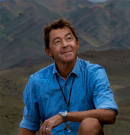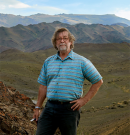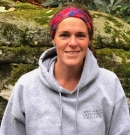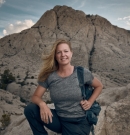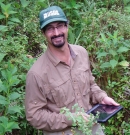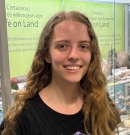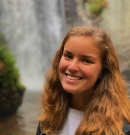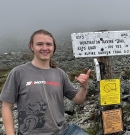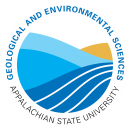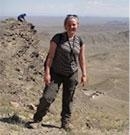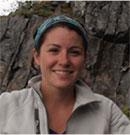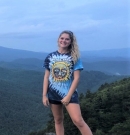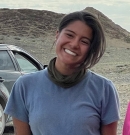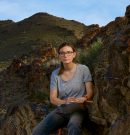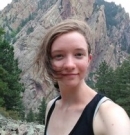Who are we?
The DAGGER (Devonian Anoxia, Geochemistry, Geochronology, and Extinction Research) team consists of paleontologists, stratigraphers, sedimentary and isotope geochemists, sedimentologists, structural geologists, and science communicators.
Dr. Sarah Carmichael and Dr. Johnny Waters of the Department of Geological and Environmental Sciences at Appalachian State University created the DAGGER group in 2015 as an offshoot of the IGCP 596 program to:
- include additional scientists from other disciplines of the geosciences,
- include science communicators and outreach specialists, and
- formally include undergraduate researchers as team members.
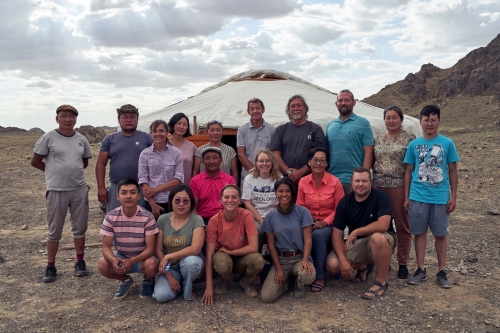
DAGGER Team Leaders
The DAGGER Team Leaders are responsible for funding and organizing international field expeditions, as well as facilitating multidisciplinary collaborations across different projects, countries, and institutions.
-
Dr. Sarah Carmichael
Dr. Sarah Carmichael is a Professor of Geological and Environmental Sciences at Appalachian State University. She is a geochemist who specializes in fluid-rock reactions in both ancient and modern environments.
photo by Felix Kunze
-
Dr. Peter Königshof
Dr. Peter Königshof leads the IGCP 596 Project. He is a conodont biostratigrapher as well as a sedimentologist, with particular expertise in microfacies analysis. He is the head of the Senckenberg Research Institute and Natural History Museum in Frankfurt, Germany.
photo by Felix Kunze
-
Dr. Johnny Waters
Johnny Waters is a paleontologist and Emeritus Professor at Appalachian State University, whose research interests include rebound from mass extinctions, Paleozoic community evolution, and the taxonomy, functional morphology, ontogeny and paleoecology of paleozoic echinoderms, especially blastoids. He was a co-leader of the IGCP 596 team.
photo by Felix Kunze
DAGGER Science Communicators
The DAGGER Science Communication team is responsible for the group's social media presence, field photography, educational outreach, and telling the Devonian extinction and recovery story to a broader audience than just geoscientists.
-
Magnus Karlson
Magnus Karlson is a videographer who is working with the DAGGER team to make educational videos that are part of the Next Generation Science Standards modules that the DAGGER science communications team is creating as part of our NSF funding ("CSI Devonian"). Magnus has worked in the field with the DAGGER science team in Nevada, Mongolia, and upstate New York.
photo by Felix Kunze
-
Felix Kunze
Felix Kunze is a photographer and lighting expert who has worked in remote and challenging locations all over the world, including Mongolia, Iceland, Namibia, and caves in the southern Appalachians. He is one of the Explorers Club portrait photographers, and is currently working on a project wherein he takes formal portraits of scientists in their field sites. The DAGGER team welcomed Felix on their National Geographic and Explorers Club Flag Expedition to Mongolia in 2018; his role was to tell a "behind the scenes" story of scientists in the field in an interesting, honest, and respectful way. His work can be seen at http://felixkunze.com.
-
Marta Toran
Marta Toran is the outreach coordinator for the Department of Geological and Environmental Sciences at Appalachian State University. She works tirelessly to engage K-12 students and the public in earth science research. She is developing Next Generation Science Standards modules based on DAGGER team projects.
DAGGER Core Science Team
The Core Science Team is responsible for the majority of the team's research, student mentorship, domestic fieldwork, and collaborations within individual disciplines.
-
D. Randy Blood
D. Randy Blood is the founder of DRB Geological Consulting. He is a geologist that specializes in stratigraphy and sedimentology and uses inorganic geochemistry to understand ancient mudrock depositional environments.
-
Dr. Diana Boyer
Dr. Diana Boyer is a Professor of Geology at Winthrop University. She is a paleoecologist who uses tools such as trace fossil and inorganic geochemistry to understand ancient depositional conditions.
photo by Felix Kunze
-
Dr. Phoebe Cohen
Dr. Phoebe Cohen is a paleobiologist at Williams College. Her expertise is on Paleozoic organic walled microfossils, which she uses to study evolution, extinctions and changing ecosystem dynamics.
-
Dr. Cole Edwards
Dr. Cole Edwards is a carbonate sedimentologist at Appalachian State University. He specializes in stable isotope signatures preserved in Ordovician and Devonian sediments in the United States.
-
Dr. Sersmaa Gonchigdorj
Dr. Sersmaa Gonchigdorj is a geologist with the Mongolian University of Science and Technology in Ulaanbaatar, Mongolia, and a member of the IGCP 596 team. She and Dr. Yarinpil Ariunchimeg oversee all Mongolian fieldwork and sample collection associated with this project.
Photo by Felix Kunze
-
Dr. Ariuntogos Munkhjargal
Dr. Ariuntogos "Ariuka" Munkhjargal is a postdoc specializing in microfacies sedimentologist at the Mongolian University of Science and Technology. She specializes in the Late Devonian sediments and fossils in the Central Asian Orogenic Belt (particularly the Paleozoic sediments of southern Mongolia).
DAGGER Affiliated Scientists
The DAGGER Affiliated Scientists represent a variety of disciplines, and all collaborate with the team leaders on DAGGER projects.
-
Dr. Yarinpil Ariunchimeg
Dr. Yarinpil Ariunchimeg is a bryozoan paleontologist and biostratigrapher with the Palaeontological Centre, Mongolian Academy of Sciences, Ulaanbaatar, Mongolia, and a member of the IGCP 596 team. She and Dr. Sersmaa Gonchigdorj oversee all Mongolian fieldwork and sample collection associated with DAGGER projects.
photo by Felix Kunze
-
Dr. Drew Coleman
Dr. Drew Coleman is an isotope geochemist at the University of North Carolina at Chapel Hill. He is primarily works with igneous rocks but is helping the group age date Devonian sediments and lava flows using a variety of techniques.
-
Dr. David De Vleeschouwer
-
Dr. Daniel Doctor
Dr. Dan Doctor is a Research Geologist for the United States Geological Survey. He is mapping Late Devonian rocks throughout the Appalachian Basin.
-
Dr. Steve Hageman
Dr. Steve Hageman is a Professor of Geological and Environmental Sciences at Appalachian State University. He is an invertebrate paleontologist and paleoecologist who studies evolution and speciation of bryozoans. His work with the DAGGER team involves oversight of and assistance with multivariate analysis of geochemical proxies for anoxia and productivity.
-
Dr. Erika Kido
Dr. Erika Kido is a paleontologist at the University of Graz, Austria and a co-leader of IGCP 596. She is an expert on Palaeozoic corals.
-
Dr. Wang Zheng
Wang Zheng is an isotope geochemist at Tianjin University, China. He is specialized in the application of metal stable isotopes (e.g., Hg, Mo, U) in rebuilding past environmental changes, such as ocean redox evolution and massive volcanism.
DAGGER Student Collaborators
Undergraduate students are an integral part of the work done for the DAGGER project.
To see samples of some of our undergraduate's work, click on Student Work
DAGGER Student Team (current)
-
Vanya Dill
Vanya is working on the magmatic evolution of island arcs during the Devonian; particularly of volcanic units in southern Mongolia.
-
Claire Grenis
Claire is part of the science communication team, and is developing NGSS (Next Generation Science Standards) educational modules on the Devonian for grades 5-12 on topics such as trace fossils, biostratigraphy, and tectonics.
-
Olivia Key
Olivia Key is an affiliate member of the DAGGER student team (the UNC-Chapel Hill branch). She has analyzed the mineralogy of Devonian sediments from the Great Basin in the western US, and her new project involves age dating volcaniclastic sediments from western Mongolia in Dr. Drew Coleman's isotope geochemistry lab.
-
Miguel Moreno
Miguel is working on the economic geology potential of black shales from the Appalachian Basin that cross the Frasnian-Famennian boundary, particular in regards to metals. He is comparing the metals content from the more restricted northern end of the Appalachian Basin to areas in the southern end of the basin that were closer to the open ocean during the Devonian.
-
Gabriel Wheaton
Gabriel is starting out his work with the DAGGER group revisiting some volcaniclastic sediments from northwestern China where the carbon and oxygen stable isotopes are puzzling. He will be reanalyzing the rock sequence using whole rock geochemistry and other techniques to refine our interpretation of what happened to create the unusual isotope signatures.
DAGGER Student Team (past)
-
Kaitlyn Anthony
As a summer research assistant through the Smoky Mountain STEM program, Kait spent the summer of 2019 determining the level of anoxia at a variety of sites in the Hongguleleng Formation in northwestern China.
(BS 2024, Appalachian State University)
-
Dr. Cameron Batchelor
Cameron worked on a geochemical study of the Late Devonian mass extinction, using 87Sr/86Sr measurements to provide information about depositional setting and diagenesis, and looking for zircons in sediments and lava flows to help constrain biostratigraphic ages. When she was not on the scanning electron microscope at Appalachian, she was working in the Geochronology and Isotope Geochemistry lab run by Dr. Drew Coleman at UNC-Chapel Hill. Cameron's fieldwork, stable isotope analyses, and zircon geochronology work during her time at Appalachian has resulted in the following publications (with more on the way):
- Carmichael, S.K., Waters, J.A., Batchelor, C.J., Coleman, D., Suttner, T.J., Kido, E., Moore, L.M., and Chadimova, L., 2016, Climate instability and tipping points in the Late Devonian: Detection of the Hangenberg Event in an open oceanic island arc in the Central Asian Orogenic Belt, Gondwana Research v. 32, p. 213-231 (doi:10.1016/j.gr.2015.02.009).
- Suttner, Thomas J., Kido, Erika, Ariunchimeg, Yarinpil, Sersmaa, Gonchigdorj, Waters, Johnny A., Carmichael, Sarah K., Batchelor, Cameron J., Ariuntogos, Munkhjargal, Hušková, Aneta, Slavik, Ladislav, Valenzuela-Ríos, José I., Liao, Jau-Chyn, and Gatovsky, Yury A., 2019, Conodonts from Late Devonian island arc settings (Baruunhuurai Terrane, western Mongolia), Palaeogeography, Palaeoclimatology, Palaeoecology (DOI: 10.1016/j.palaeo.2019.03.001)
Cameron completed her Ph.D. in isotope geochemistry at the University of Wisconsin-Madison in 2021, and a postdoc at MIT in 2024. She now works as a scientist for the Wisconsin Department of Natural Resources.
(Ph.D. 2021, University of Wisconsin-Madison; B.S. 2015, Appalachian State University)
-
Ricky Carland
Ricky's senior thesis involved searching for inorganic markers of extinction across the FF and DC boundaries in sediments in the Great Basin of Utah. He is now a staff geologist at Montrose Environmental.
(B.S. 2024, Appalachian State University)
-
Cara Cywinski
Cara's senior thesis involved a detailed sedimentological analysis of the Xom Na formation in Vietnam to determine the extent of anoxia in a Devonian carbonate platform during the Frasnian-Famennian mass extinction. Her work consisted of multiple analyses of an ultrapure carbonate and will help develop best practices for detecting anoxia in ultrapure carbonate systems. She is now an environmental scientist with Airbox America.
(B.S. 2023, Appalachian State University)
-
Dr. Aubry DeReuil
Aubry's undergraduate senior thesis "Sedimentation, Geochemistry, and Mineralogy across the Frasnian-Fammenian Boundary, northwestern China" was an important contribution to one of the first DAGGER projects. Aubry recognized that the size distribution of framboidal pyrite can be used to determine the extent and severity of ocean anoxia in sediments that are not black shales, which was published in:
- Carmichael, Sarah K., Waters, Johnny A., Suttner, Thomas J., Kido, Erika, and DeReuil, Aubry, 2014, A New Model for the Kellwasser Anoxia Events (Late Devonian): Shallow Water Anoxia in an Open Oceanic Setting in the Central Asian Orogenic Belt, Palaeogeography, Palaeoclimatology, Palaeoecology, v. 399, p. 394-403
After graduating from Appalachian, Aubry earned her Ph.D. in Sedimentology at the University of Utah, and now works for Zanskar Geothermal & Minerals, Inc. as a structural geologist.
(Ph.D., 2020, University of Utah; B.S. 2013, Appalachian State University)
-
Allison Dombrowski
Allison has performed a wide variety of analyses for her Devonian work. She has characterized the mineralogy and Sr isotope signatures of sediments from China, Belgium, and southeast Asia from the Middle and Late Devonian, and analyzed stable isotopes of strontium in the Geochronology and Isotope Geochemistry lab run by Dr. Drew Coleman at UNC-Chapel Hill. Her Sr isotope work was included in the following publication:
- *Paschall, Olivia C., Carmichael, Sarah K.,Waters, Johnny A., Koenigshof, Peter, Ta, Phuong H. Komatsu, Toshifumi, and *Dombrowski, Allison D., 2019, The Hangenberg Event in Vietnam: sustained ocean anoxia with a volcanic trigger?, Global and Planetary Change (Special issue on Devonian global changes - recent advances and challenges in different domains, eds. G. Racki and P. Wignall), v. 175, p. 64-81 (DOI: 10.1016/j.gloplacha.2019.01.021) - click here for institutional repository copy with supplemental data
Most recently, she has been part of the research team that went to Mongolia in 2018 to study mass extinctions in island arc environments; for her senior thesis, Allison characterized a series of volcanic ash units from the Late Devonian to track magma evolution of volcanoes in the East Junggar Arc. This work was published in 2020 in a special issue of Palaeobiodiversity and Palaeoenvironments:
- Ariuntogos, M., Königshof, P., Hartenfels, S., Jansen, U., Nazik, A., Carmichael, S. K., Waters, J. A., Sersmaa, G., Crônier, C., Ariunchimeg, Y., *Paschall, O. C., and *Dombrowski, A., 2020, The Hushoot Shiveetiin gol section (Baruunhuurai Terrane): Sedimentology and facies from a Late Devonian island arc setting: Palaeobiodiversity and Palaeoenvironments (special issue: The Central Asian Orogenic Belt (CAOB) during Late Devonian: new insights from southern Mongolia) (DOI: 10.1007/s12549-020-00445-0)
After graduating from Appalachian and working for the United States Geological Survey for several years, Allison is finishing up her MS in Geology UNC Wilmington and is a collections manager at the NC Museum of Natural Sciences.
(M.S. in progress, UNC Wilmington; B.S. 2020, Appalachian State University)
-
Kathleen Duckett
Katie's senior thesis involved analyzing volcanic rocks from a new site in Mongolia to help determine the tectonic and paleoenvironment setting of a suite of Devonian-Carboniferous fossils in a tectonically complex terrane. She now runs ROOT, a clothing company dedicated to conservation (read more about it here).
(B.S. 2021, Appalachian State University)
-
Josh Feierstein
Josh worked extensively on this project from the data management angle, working to incorporate gigabites of data we've collected over the past four years into a useable web interface. His work is the Data Portal part of this website. He received his Professional Geologist (P.G.) License in 2019 and is the owner of Natural Geodata, LLC.
Click here to see examples of his work.
(Natural Geodata, LLC., B.S. 2015, Appalachian State University)
-
Iris Ferris
Iris worked extensively on characterizing Mongolian sediments with X-ray diffraction.
-
Jacqui Foronda
For her senior thesis, Jacqui analyzed Middle Devonian coral reef communities in the context of modern patch reefs within volcanic island arc sequences, from rocks in Shine Jinst, Mongolia.
(B.S. 2023, Appalachian State University)
-
Ben Goodridge
Ben completed his thesis on modeling paleozoic groundwater flow across modern volcanic arc morphologies to predict what locations might preserve isotopic evidence of submarine groundwater discharge vs pure seawater.
(B.S. 2025, Appalachian State University)
-
John Granholm
John began working on deciphering football-sized spherical nodules (microbialites?) from Mongolian sediments in Fall 2015, and by Spring 2016 he was working on sediments that cross the Devonian-Carboniferous boundary from the Namur-Dinant basin in Belgium.
In 2016 he was named a runner up in the AGU Data Visualization contest for his virtual reality work in tectonic reconstructions. He is now teaching robotics at Wake Tech Community College.
(B.S. 2017, Appalachian State University)
-
Lilith Hazzard
Lilith worked to characterize the mineralogy of Devonian sediments from a variety of locations using X-ray diffraction and scanning electron microscopy. Her work culminated in a detailed characterization of titanium-based minerals from the Hushoot Givetiin Gol section of western Mongolia, and their role in tracking fluid flow processes in volcaniclastic sediments.
(B.S. 2021, Appalachian State University)
-
Kieran Krommes
Kieran worked on characterizing Late Devonian anoxia events recorded in sediments from Virginia (USA), and determining the specific provenance of these sediments. She is now a science teacher for Guilford County Schools.
(B.S. 2018, Appalachian State University)
-
Logan T Little
Logan compared the trace element signatures of sediments from a variety of paleotectonic regimes across the Hangenberg Event using a variety of statistical methods. His senior thesis used PAST software and built on a decade of work from previous DAGGER students to find patterns of trace element behavior across the Devonian-Carboniferous boundary in as many paleoenvironments as possible.
(M.S. in progress, University of Minnesota - Duluth, B.S. 2021, Appalachian State University)
-
Caelan McCaskill
While at Appalachian, Caelan worked on the organic carbon content of late Devonian reef systems from Utah and Nevada as well as samples from the Xom Na section in Vietnam.
(B.S. 2023, Appalachian State University)
-
L. McCain Moore
McCain spent a significant amount of time in the XRD lab working to determine the mineralogy of the Late Devonian Heishantou Formation in northwestern China. This work resulted in her contribution to the following publication:
Carmichael, S.K., Waters, J.A., *Batchelor, C.J., Coleman, D., Suttner, T.J., Kido, E., *Moore, L.M., and Chadimova, L., 2016, Climate instability and tipping points in the Late Devonian: Detection of the Hangenberg Event in an open oceanic island arc in the Central Asian Orogenic Belt, Gondwana Research v. 32, p. 213-231 (doi:10.1016/j.gr.2015.02.009).
She is currently a geologist with the Insight Group in South Carolina.
(B.S. 2015, Appalachian State University)
-
Olivia Paschall
Olivia's work documented the severity of anoxia in basinal sediments from Vietnam on the south China platform at the Devonian-Carboniferous boundary, and postulated that massive volcanism could be a trigger for the Hangenberg Crisis. Her work on this topic was published in 2019:
- Paschall, Olivia C., Carmichael, Sarah K.,Waters, Johnny A., Koenigshof, Peter, Ta, Phuong H. Komatsu, Toshifumi, and Dombrowski, Allison D., 2019, The Hangenberg Event in Vietnam: sustained ocean anoxia with a volcanic trigger?, Global and Planetary Change (Special issue on Devonian global changes - recent advances and challenges in different domains, eds. G. Racki and P. Wignall), v. 175, p. 64-81 (DOI: 10.1016/j.gloplacha.2019.01.021) - click here for institutional repository copy with supplemental data
Olivia was also responsible for mapping the Hushoot Givetiin Gol in 2018 as part of a National Geographic expedition to southwest Mongolia. Her map was published in 2020 in a special issue of Palaeobiodiversity and Palaeoenvironments:
- Ariuntogos, M., Königshof, P., Hartenfels, S., Jansen, U., Nazik, A., Carmichael, S. K., Waters, J. A., Sersmaa, G., Crônier, C., Ariunchimeg, Y., *Paschall, O. C., and *Dombrowski, A. D., 2020, The Hushoot Shiveetiin gol section (Baruunhuurai Terrane): Sedimentology and facies from a Late Devonian island arc setting: Palaeobiodiversity and Palaeoenvironments (special issue: The Central Asian Orogenic Belt (CAOB) during Late Devonian: new insights from southern Mongolia) (DOI: 10.1007/s12549-020-00445-0)
Olivia is now working on her Ph.D. in geophysics at Cornell University.
(Ph.D. in progress, Cornell University; B.S. 2018, Appalachian State University)
-
Sonia Sanchez
Sonia has been instrumental in making a detailed petrologic characterization of the Late Devonian Zhulumute Formation in northwestern China. After several years in the oil and gas industry, she is now working as a software developer.
(M.S. 2017, University of Cincinnati; B.S. 2014, Appalachian State University)
-
Carter Smith
Carter's research encompassed sulfur and carbon isotopes recorded in the Late Devonian reef systems in the Great Basin area of the western US (Utah/Nevada).
(B.S. 2023, Appalachian State University)
-
Robert Thomas
Robert started working with the DAGGER group using his Photoshop expertise in combination with recent (2010 - present) tectonics literature to update the positions of island arcs on paleogeographic maps of the Late Devonian (from Ron Blakey's maps, Colorado Plateau Geosystems, Inc.). His senior thesis characterized the petrology (igneous and sedimentary) of Mongolian rocks from the Hushoot Shiveetiin Gol site, which were collected by IGCP 596/580 in 2014. Since graduating from Appalachian, he has earned another degree in civil engineering and now works for Artisan Skateparks.
(B.E. 2021, Civil Engineering, NC State University; B.S. 2017, Geology, Appalachian State University)
-
Casey Weber
While at Appalachian, Casey did preliminary work to determine the feasibility of using FT-IR to detect organic compounds preserved in Asian sediments that record the Kellwasser and Hangenberg Events.
(B.S. 2019, Penn State Altoona)
-
Matthew Wilson
Matt characterized the sedimentology surrounding the the Late Devonian annulata Event in Chinese sediments. He is now working for the National Weather Service.
(B.S. 2016, Appalachian State University)
-
Alex Zacher
Alex characterized the severity of the Hangenberg Event from the Namur-Dinant basin in Belgium using pyrite framboid distributions. Alex now works for Terracon as a geoscience technician.
(B.S. 2021, Appalachian State University)


